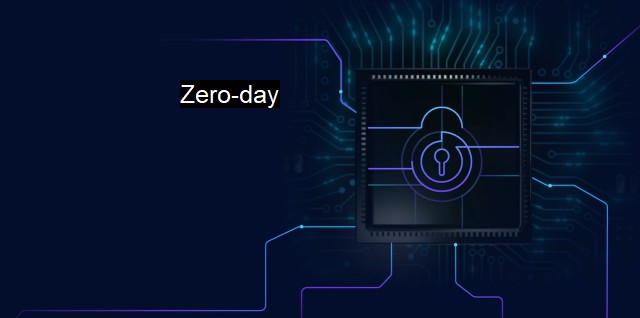What is Zero-day?
Zero-Day in Cybersecurity: Understanding the Threats and Vulnerabilities
The term "Zero-day" refers to a software vulnerability that is unknown to the parties interested in its correction such as the vendor or antivirus programmers. Named reasonably for the fact that there is zero, or no day(s), time to patch or prepare against a potential exploit, it denotes an immense threat to digital security due to its inherent unpredictability and volatile nature. As such, exploiting a zero-day vulnerability allows malicious code or programs to infiltrate, gather sensitive data, or cause significant disruptions in targeted systems without any prior detection or warning.The perilous potency of zero-day attacks lies in their expeditious nature and the inability of system defenders to patch them before an attack is executed. A zero-day vulnerability is not merely a software bug that causes your system to restart unexpectedly or your browser to crash. It involves hole-affording powers that hackers can exploit to deliver malicious content, create backdoor access points, and more. Regrettably, vendors are often unaware of these vulnerabilities until an attack has been executed or reported.
Given their stealthy nature, hackers can arm themselves with zero-day vulnerabilities for months or even years, continually compromising targeted systems without detection. Many of these vulnerabilities go undiscovered until they've already been exploited. But once one is detected, it's a race against time to repair or patch the system before further exploits can occur.
When protecting against zero-day attacks, antivirus programs work tirelessly to find and fix potential security risks. Despite the word "antivirus," modern antivirus software doesn't just protect against viruses but creates a robust security layer against worms, ransomware, and zero-day attacks. The software conducts real-time analysis of files, scanning them for known digital threats and observing suspicious behavior. the challenge that the antivirus software might encounter lies in the fact that they are programmed to execute security patches or countermeasures for known threats. Consequently, a zero-day’s significance is exemplified through its basis in the unknown.
Antivirus software aims to ensure that this unknown realm is significantly diminished and manageable to deal with by employing some strategies. Behavior-based detection, for instance, allows protective software to detect suspicious activities which do not conform to the norms of the known system operations. Sandboxing is another measure, which isolates potentially harmful programs within a distinct, constrained environment which limits any harm they can cause.
By regularly updating definitions, supplementing newer signatures and deploying heuristic analysis, antivirus software has been a resourceful line of defense. Heuristic analysis allows antivirus software to analyze a file and decide whether it is potentially harmful even if it does not match any known threats. Employing machine learning and AI capabilities, heuristic methods are better able to predict an irregularity or threat from a zero-day attack even before its execution.
While having a robust antivirus program is a good step toward guarding against zero-day threats, it cannot provide absolute security. People are encouraged to regularly update their software, as updates often include patches once a new vulnerability is discovered.
Companies managing sensitive data should have rigorous testing processes, perhaps employing 'red teams' to try to breach their systems, helping identify potential vulnerabilities. Regular risk evaluations, security audits, and user awareness training would also go a long way in enhancing an organization’s cybersecurity posture and reducing the risk posed by zero-day vulnerabilities.
Zero-day exploits present a significant challenge to cybersecurity professionals and antivirus programs, given their inherent characteristic of unpredictability. Therefore, adopting a strategy that combines robust antivirus software, regular security updates, and a proactive approach to uncover potential vulnerabilities helps an organization or an individual better defend against a zero-day threat.

Zero-day FAQs
What is a zero-day vulnerability?
A zero-day vulnerability is a security flaw in a software or system that is unknown to the vendor and has not been patched yet. Attackers can exploit this vulnerability to launch cyberattacks on the affected system.How do zero-day attacks happen?
Zero-day attacks happen when cybercriminals exploit previously unknown vulnerabilities in a software or system. They use these vulnerabilities to create malware and then distribute it to unsuspecting users through various channels like email, social media, or malicious websites.How can I protect myself from zero-day attacks?
To protect yourself from zero-day attacks, you can use antivirus solutions that detect and block malicious software. You can also keep your software updated with the latest patches and security updates to prevent attackers from exploiting known vulnerabilities. Additionally, be vigilant when downloading files or opening links from unknown sources or suspicious emails.What should I do if I suspect a zero-day attack?
If you suspect a zero-day attack, immediately contact your IT department or security team. They can investigate the issue and take appropriate measures to contain and mitigate the damage. It's also recommended to disconnect the affected system from the network and avoid using any external devices until the issue is resolved.| | A | | | B | | | C | | | D | | | E | | | F | | | G | | | H | | | I | | | J | | | K | | | L | | | M | |
| | N | | | O | | | P | | | Q | | | R | | | S | | | T | | | U | | | V | | | W | | | X | | | Y | | | Z | |
| | 1 | | | 2 | | | 3 | | | 4 | | | 7 | | | 8 | | |||||||